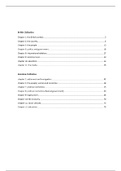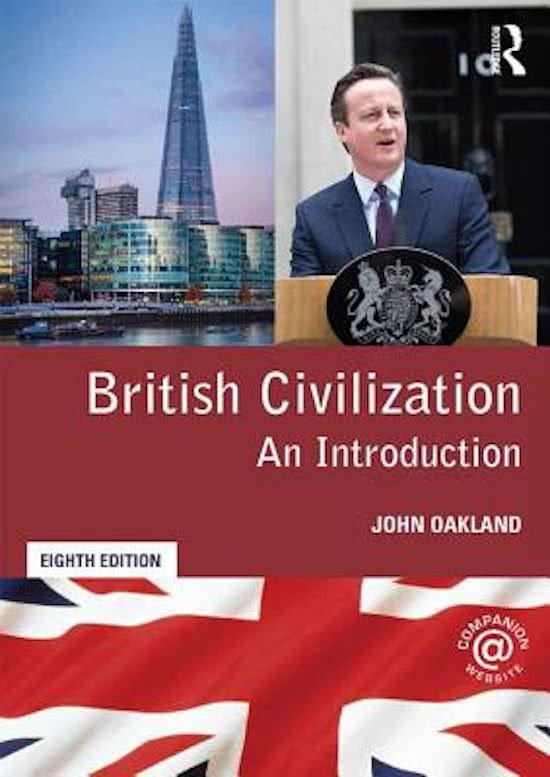,BRITISH CIVILIZATION
,CHAPTER 1: THE BRITISH
CONTEXT
HISTORICAL GROWTH
Title today: the United Kingdom of Great Britain and Northern Ireland (UK)
Large and smaller islands off the north-western European mainland (touched by the North
Sea, English Channel, Irish Sea and Atlantic Ocean.)
Great Britain is the biggest island and is divided into:
1. England
2. Scotland
3. Wales
4. Northern Ireland
Division in pre-history:
1. Old Stone Age
2. Middle Stone Age
3. New Stone Age
Invasions of Celtic groups, Belgic tribes, Romans, Germanic tribes = Anglo-Saxons influenced the
social and political structures of the country. The islands experienced a lot of invasions. One of
them:
THE NORMAN CONQUEST
Norman Conquest, the military conquest of England by William, duke of Normandy, primarily
effected by his decisive victory at the Battle of Hastings (October 14, 1066) and resulting ultimately in
profound political, administrative, and social changes in the British Isles.
The conquest was the final act of a complicated drama that had begun years earlier, in the reign of
Edward the Confessor, last king of the Anglo-Saxon royal line. Edward, who had almost certainly
designated William as his successor in 1051, was involved in a childless marriage and used his lack of
an heir as a diplomatic tool, promising the throne to different parties throughout his reign, including
Harold Godwineson, later Harold II, the powerful earl of Wessex. The exiled Tostig, who was Harold’s
brother, and Harald III Hardraade, king of Norway, also had designs on the throne and threatened
invasion. Amid this welter of conflicting claims, Edward from his deathbed named Harold his
successor on January 5, 1066, and Harold was crowned king the following day. However, Harold’s
position was compromised, according to the Bayeux Tapestry and other Norman sources, because in
1064 he had sworn an oath, in William’s presence, to defend William’s right to the throne.
From almost the beginning of his reign, Harold faced challenges to his authority. Tostig began raiding
the southern and eastern coasts of England in May, eventually joining forces with Harald III. Harold
was able to keep his militia on guard throughout the summer but dismissed it early in September,
when he ran out of supplies and his peasant soldiers needed to return to their fields for the harvest.
This left the south without defenses, exposing it to invasion by William. Before William arrived,
however, Harald III and Tostig invaded in the north; Harold hastened to Yorkshire, where at Stamford
Bridge (September 25) he won a smashing victory in which both Harald III and Tostig perished.
Bayeux Tapestry = a 70 metre cloth made in England in 1070, depicting events leading to the
Norman Conquest
,Ireland and Wales had been under English control since the 12 th and 13th centuries. But in 1921,
Southern Ireland left the union to become the independent Republic of Ireland while Northern
Ireland remained part of the UK.
Britain developed an early manufacturing and financial base with connections to Europe
Been responsible for major and influential scientific medical and technological advances.
Had become a dominant industrial and political world power in the 19 th century.
FUNDAMENTAL POLITICAL REFORMS:
Extension of vote
Increasing authority of the elected House of Commons
SOCIAL CHANGES:
Growth labour movement
Formation labour party
Creation of welfare state (Attlee)
These later changed in the 20th century as new political parties developed, and government economic
policies shifted. Britain’s first woman prime minister Thatcher and her Conservative government
were central to these developments attracted strong support and fierce opposition.
1. CLEMENT ATTLEE
First labour prime minister
Inaugurated radical reform welfare state, NHS, nationalization of private industry into
public services
He was in favor of the public services
2. MARGARET THATCHER
Concervative prime minister
First British woman prime minster
Introduced privatization programmes and denationalization of public services
She was against the public services
There were battles between:
1. Centre-left parties = Labour
2. Centre-right parties = Conservative
The social and economic strength was reduced by the effects of the two world wars. After the Second
World War, Britain had to adjust with difficulty to a withdrawal from empire. The nation had been
forced into a search for a new identity and direction, internationally and nationally.
CONTEMPORARY CONDITIONS
Britain today is a complex society in which diversity and change have created problems as
well as advantages
The country seems homogeneous but that is not the case because there are existing divisions
because of dominance and influence of London on the rest of the country.
Britains feel that they have become more aggressive, selfish, less tolerant, less kind, less
moral,..
There are cultural gaps between the north and the south
A lot of people believe that Britain is going into the wrong direction (2010)
Their society has been affected by mistrust, cynicism, materialism, egotism,..
,ATTITUDES
They may often give accurate pictures of what is happening at the grass roots, although they
do have to be approached with a certain caution.
Public responses may tend to deal with topical rather than long-term concerns and may vary
considerably within a short period of time.
Increasing dissatisfaction with politicians
Britain’s most pressing concerns:
1. More pressing concerns emerged about immigration/immigrants, which were in first place
with 45 per cent after being in second place in March 2010 with 33 per cent.
2. The economy (which had experienced significant growth in 2014 and 2015) had been pushed
down from first place at 55 per cent in March 2010 (the previous general election year) to
third place at 28 per cent.
3. The National Health Service (NHS) had moved to second place with 38 per cent after a fifth
place in March 2010 at 20 per cent and frequently appears high in the listings.
4. Unemployment was at 21 per cent in fourth place (the same as in 2010).
5. Education/schools had risen to fifth at 20 per cent from sixth in 2010 at 19 per cent.
6. Poverty/inequality at 16 per cent had risen significantly to sixth place in the list;
This suggested that immigration numbers were now a dominant factor for respondents, but that race
relations were no longer a major issue.
, CHAPTER 2: THE COUNTRY
GEOGRAPHICAL IDENTITIES
title for constitutional and political purposes is the United Kingdom of Great Britain and
Northern Ireland (the UK and Britain for short).
Britain comprises a number of islands lying off the north-west coast of continental Europe,
which are often known as the British Isles.
The mainland of England, Scotland and Wales forms the largest island with the political title
of Great Britain.
Northern Ireland shares the second-largest island with the Republic of Ireland, which has
been politically independent since 1921.
Smaller islands, like Anglesey, the Isle of Wight and the Orkneys, Shetlands, Hebrides and
Scillies, are also part of the British political union.
And then there are hybrids such as the Isle of Man and the Channel Islands.
Isle of Man in the Irish sea and the Channel Islands off North Coast France are not part of the
UK. They have their own identities and legal systems and they also have their own Crown
Dependencies= Historical relationships with the British crown but British government is
responsible for their defense and foreign relation. They can intervene if administration is not
maintained.
REGIONS IN BRITAIN
Britain has sometimes been divided into geographic 'regions' (areas). These may reflect a specific
identity, especially when they concern devolved nations, but arguably much less so for the English
regions. Regions are not the same as modern local government structures and are geographically
larger. They have served as assistance and development areas service locations as gas, water,..
Following devolution, Scotland, Wales and Northern Ireland became self-governing 'national' units
rather than 'regions'.
Nine regions were created in England, which took the form of Regional Development
Agencies (RDAs).
They were unelected politico-economic structures, which were appointed by government to
organize and maximize regional development.
Today the English regions no longer have a devolved government role, but their areas do
have some administrative purposes, form the constituency boundaries for regional elections
to the EU Parliament, are the names of BBC broadcasting regions and serve as a basis for
regional statistics..
The future of devolution structures in the UK is uncertain.
1. London
2. South East
3. South West
4. East of England
5. East Midlands
6. West Midlands
7. Yorkshire and the Humber
8. North East
9. North West





